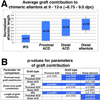STELLA-positive subregions of the primitive streak contribute to posterior tissues of the mouse gastrula
- PMID: 22019303
- PMCID: PMC3288210
- DOI: 10.1016/j.ydbio.2011.10.003
STELLA-positive subregions of the primitive streak contribute to posterior tissues of the mouse gastrula
Erratum in
- Dev Biol. 2012 Jun 15;366(2):435
Abstract
The developmental relationship between the posterior embryonic and extraembryonic regions of the mammalian gastrula is poorly understood. Although many different cell types are deployed within this region, only the primordial germ cells (PGCs) have been closely studied. Recent evidence has suggested that the allantois, within which the PGCs temporarily take up residence, contains a pool of cells, called the Allantoic Core Domain (ACD), critical for allantoic elongation to the chorion. Here, we have asked whether the STELLA-positive cells found within this region, thought to be specified PGCs, are actually part of the ACD and to what extent they, and other ACD cells, contribute to the allantois and fetal tissues. To address these hypotheses, STELLA was immunolocalized to the mouse gastrula between Early Streak (ES) and 12-somite pair (-s) stages (~6.75-9.0 days post coitum, dpc) in histological sections. STELLA was found in both the nucleus and cytoplasm in a variety of cell types, both within and outside of the putative PGC trajectory. Fate-mapping the headfold-stage (~7.75-8.0 dpc) posterior region, by which time PGCs are thought to be segregated into a distinct lineage, revealed that the STELLA-positive proximal ACD and intraembryonic posterior primitive streak (IPS) contributed to a wide range of somatic tissues that encompassed derivatives of the three primary germ layers. This contribution included STELLA-positive cells localizing to tissues both within and outside of the putative PGC trajectory. Thus, while STELLA may identify a subpopulation of cells destined for the PGC lineage, our findings reveal that it may be part of a broader niche that encompasses the ACD and through which the STELLA population may contribute cells to a wide variety of posterior tissues of the mouse gastrula.
Copyright © 2011 Elsevier Inc. All rights reserved.
Figures






Similar articles
-
STELLA collaborates in distinct mesendodermal cell subpopulations at the fetal-placental interface in the mouse gastrula.Dev Biol. 2017 May 1;425(1):44-57. doi: 10.1016/j.ydbio.2017.03.014. Epub 2017 Mar 18. Dev Biol. 2017. PMID: 28322735 Free PMC article.
-
PRDM1/BLIMP1 is widely distributed to the nascent fetal-placental interface in the mouse gastrula.Dev Dyn. 2017 Jan;246(1):50-71. doi: 10.1002/dvdy.24461. Epub 2016 Nov 12. Dev Dyn. 2017. PMID: 27696611 Free PMC article.
-
The Allantoic Core Domain: new insights into development of the murine allantois and its relation to the primitive streak.Dev Dyn. 2009 Mar;238(3):532-53. doi: 10.1002/dvdy.21862. Dev Dyn. 2009. PMID: 19191225 Free PMC article.
-
The mouse fetal-placental arterial connection: A paradigm involving the primitive streak and visceral endoderm with implications for human development.Wiley Interdiscip Rev Dev Biol. 2020 Mar;9(2):e362. doi: 10.1002/wdev.362. Epub 2019 Oct 17. Wiley Interdiscip Rev Dev Biol. 2020. PMID: 31622045 Review.
-
Mouse primordial germ cells: a reappraisal.Int Rev Cell Mol Biol. 2014;309:1-57. doi: 10.1016/B978-0-12-800255-1.00001-6. Int Rev Cell Mol Biol. 2014. PMID: 24529721 Review.
Cited by
-
Visceral endoderm and the primitive streak interact to build the fetal-placental interface of the mouse gastrula.Dev Biol. 2017 Dec 1;432(1):98-124. doi: 10.1016/j.ydbio.2017.08.026. Epub 2017 Sep 5. Dev Biol. 2017. PMID: 28882402 Free PMC article.
-
Evolving Lessons on Metazoan Primordial Germ Cells in Diversity and Development.Mol Reprod Dev. 2025 May;92(5):e70027. doi: 10.1002/mrd.70027. Mol Reprod Dev. 2025. PMID: 40349219 Free PMC article. Review.
-
From in vivo to in vitro: exploring the key molecular and cellular aspects of human female gametogenesis.Hum Cell. 2023 Jul;36(4):1283-1311. doi: 10.1007/s13577-023-00921-7. Epub 2023 May 26. Hum Cell. 2023. PMID: 37237248 Review.
-
Defining the neighborhoods that escort the oocyte through its early life events and into a functional follicle.Mol Reprod Dev. 2013 Dec;80(12):960-76. doi: 10.1002/mrd.22232. Epub 2013 Sep 16. Mol Reprod Dev. 2013. PMID: 24105719 Free PMC article. Review.
-
Physiologic Course of Female Reproductive Function: A Molecular Look into the Prologue of Life.J Pregnancy. 2015;2015:715735. doi: 10.1155/2015/715735. Epub 2015 Dec 1. J Pregnancy. 2015. PMID: 26697222 Free PMC article. Review.
References
-
- Anderson R, Copeland TK, Scholer H, Heasman J, Wylie C. The onset of germ cell migration in the mouse embryo. Mechanisms of Development. 2000;91:61–68. - PubMed
-
- Beddington RSP. An autoradiographic analysis of tissue potency in different regions of the embryonic ectoderm during gastrulation in the mouse. Journal of Embryology and Experimental Morphology. 1982;69:265–285. - PubMed
-
- Beddington RSP. Isolation, culture and manipulation of post-implantation mouse embryos. In: Monk M, editor. Mammalian Development: A Practical Approach. Oxford: IRL Press; 1987. pp. 43–69.
-
- Boisset JC, van Cappellen W, Andrieu-Soler C, Galjart N, Dzierzak E, Robin C. In vivo imaging of haematopoietic cells emerging from the mouse aortic endothelium. Nature. 2010;464:116–120. - PubMed
Publication types
MeSH terms
Substances
Grants and funding
LinkOut - more resources
Full Text Sources
Molecular Biology Databases

